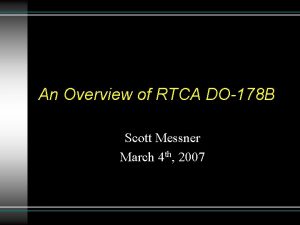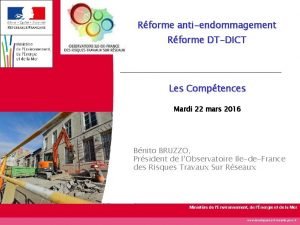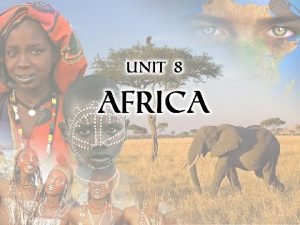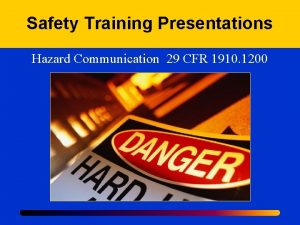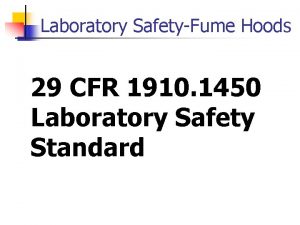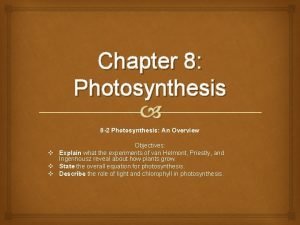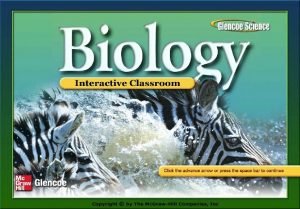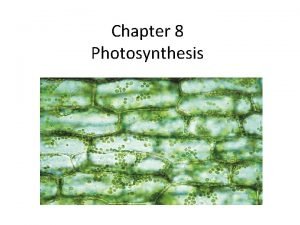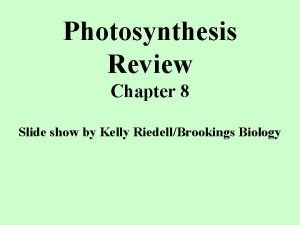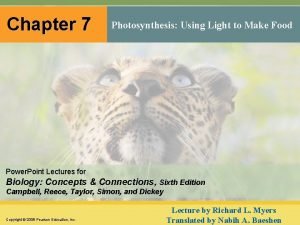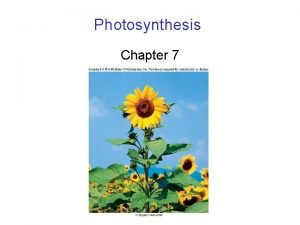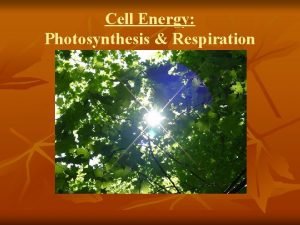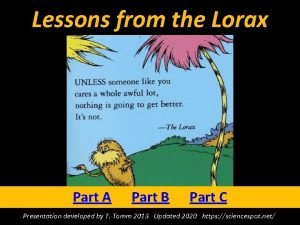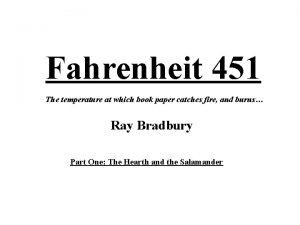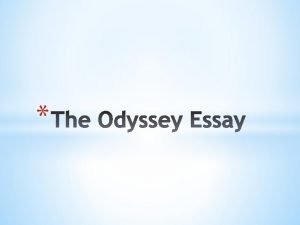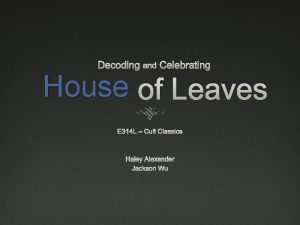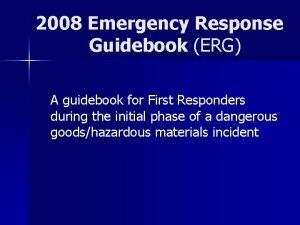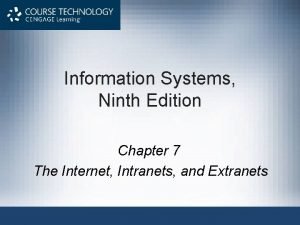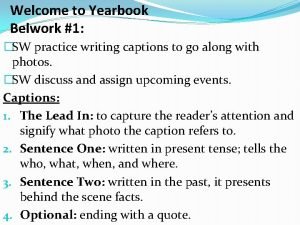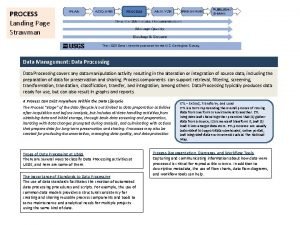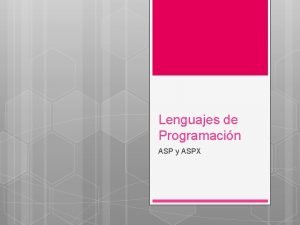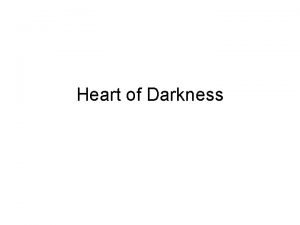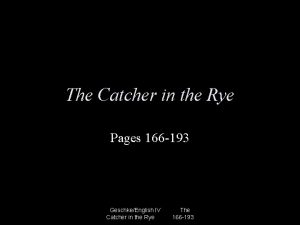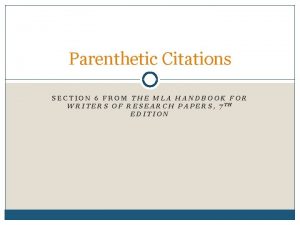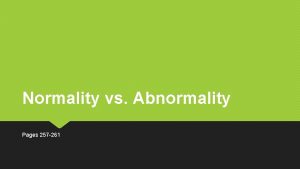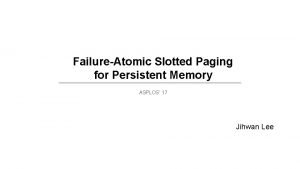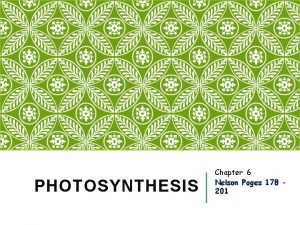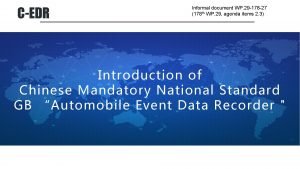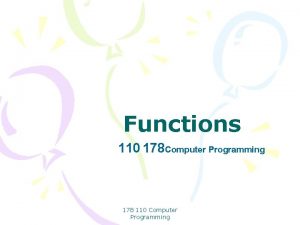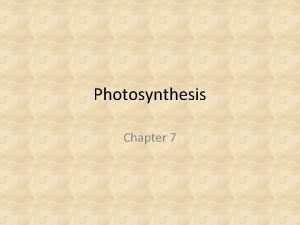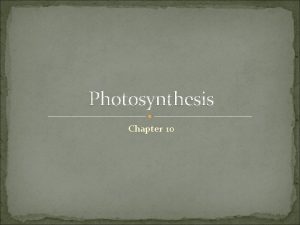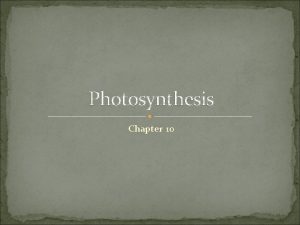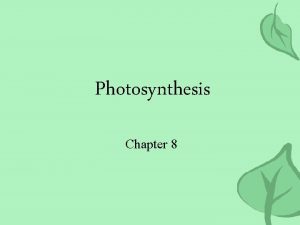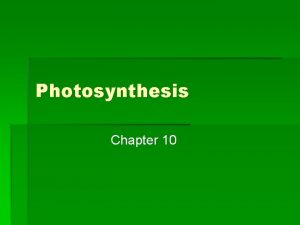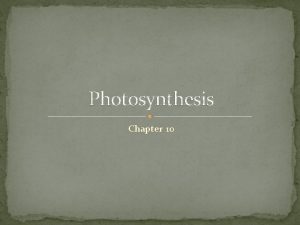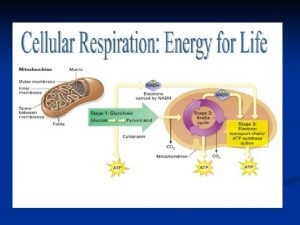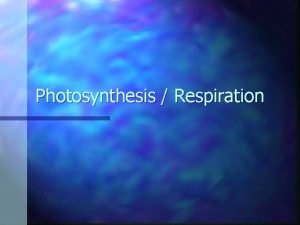PHOTOSYNTHESIS Chapter 6 Nelson Pages 178 201 6






















































- Slides: 54

PHOTOSYNTHESIS Chapter 6 Nelson Pages 178 - 201

6. 1 Chloroplasts and photosynthetic pigments Biology 20 Chapter 6 Photosynthesis 2

Curricular Outcomes 20–C 2. 4 k Summarize and explain the role of ATP in cell metabolism 20–C 1. 1 k Explain, in general terms, how pigments absorb light and transfer that energy as reducing power in nicotinamide adenine dinucleotide phosphate (NADP), reduced nicotinamide adenine dinucleotide phosphate (NADPH) and finally into chemical potential in adenosine triphosphate (ATP) by chemiosmosis, describing where those processes occur in the chloroplast 20–C 1. 2 k Explain, in general terms, how the products of the light-dependent reactions, NADPH and ATP, are used to reduce carbon in the light-independent reactions for the production of glucose, describing where the process occurs in the chloroplast. 3

Photosynthesis A process that converts solar energy into chemical energy Mean ‘Light” and “to make or build”. Remember the chemical formula for P. S! 4


Light travels in waves called PHOTONS Each photon is a small unit of energy Photons with short wavelengths have HIGH energy (bad for us!) Ex. UV rays, x-rays, gamma rays Photons with long wavelengths have LOW energy Ex. infrared, microwaves, radio waves 6

Plants use VISIBLE LIGHT ENERGY for PHOTOSYNTHESIS : Visible light is pure white light of wavelengths from 380 nm to 750 nm Medium wavelength energy Have you heard of Roy G. Biv? ? ? Red, Orange, Yellow, Green, Blue, Indigo, Violet See page 180 Figure 1 (a) & (b) 7


Chlorophyll a green coloured PIGMENT found in plants, algae, protists, and cyanobacteria chlorophyll absorbs the PHOTONS and begins the process of photosynthesis CHLOROPHYLL A (bright green) is the MOST IMPORTANT PIGMENT other pigments like chlorophyll b (dull green), carotene (orange), etc. are “helpers” called. . . 9

Accessory pigments these helpers absorb other photon wavelengths and pass their energy to chlorophyll a Hmmm. . . Why do leaves turn many different colours in the fall? ? ? a SPECTROPHOTOMETER can accurately show which pigments absorb which wavelengths (colours) see p. 182 Fig 3 10

The Absorption Spectrum of Chlorophyll a and Chlorophyll b 11

Chloroplasts Clusters of CHLOROPHYLL are found in plant organelles called CHLOROPLASTS yep… they’re green! Structure of a chloroplast: Outer & Inner Membrane Thylakoid Membranes (Discs): contain chlorophyll Grana: stacks of Thylakoid Discs Stroma: gel-like enzyme-rich substance filling the chloroplast 12


Leaf structure Most chloroplasts are found in a layer of cells at the TOP of a leaf The PALISADE MESOPHYLL LAYER Why? The sun first passes through the waxy cuticle, then through the upper epidermis, then finally to the Palisade Mesophyll layer 14


Check Your Understanding: 1. What is chlorophyll? 2. Identify the regions of the chloroplast indicated on this diagram. Describe what happens in B and C. 3. Describe the major function of photosynthetic pigments. 16


Assignments: q. Supplementary diagrams q. Practice Problems #1 -4 q. Section 6. 1 Questions – page 185 # 1 -4 18

Practice Problems Text - Key (Page 181) 1. plants, plantlike protests, cyanobacteria 2. (a) Light, or electromagnetic radiation, is a form of energy that travels at 3 × 108 m/s in the form of photons. (b) A photon is a small unit of energy of a particular wavelength. (Page 182) 3. Chlorophyll is the primary light-absorbing pigment in all photosynthetic organisms. 4. In general, chlorophyll a and b absorb blue-violet and regions. Specifically, chlorophyll a absorbs more in the dark blue and orange regions and chlorophyll b absorbs more in the light blue and dark yellow regions. They both transmit green light. 19

Section 6. 1 Questions – page 185 # 1 -4 - Key 1. (a) As the wavelength gets longer, the energy in a photon decreases, and as the wavelength increases, the energy increases. (b) Green light possesses a higher energy value than red light because it has a shorter wavelength. (c) The colour of light is determined by its wavelength. A higher wavelength has lower energy. Red light is 750 nm, whereas violet light is 380 nm. 2. (a) Green plants contain chlorophyll a, chlorophyll b, carotenoids, xanthophylls, and anthocyanins. (b) Yellow-coloured pigments are visible only in autumn leaves because the chlorophyll pigments mask the yellow-coloured pigments the rest of the year. Plants stop producing chlorophyll in the autumn, so only the yellow, red, and brown colours are visible. 3. All photosynthetic organisms contain the molecule chlorophyll to capture electromagnetic radiation. 4. A – thylakoid B – stroma C – inner envelope membrane D – outer envelope membrane 20

Interesting History Note (FYI only) Melvin Calvin studied photosynthesis by working with organic compounds labeled with carbon-14. Using carbon-14 and the new techniques of ion exchange, paper chromatography, and radioautography, Calvin and his many associates mapped the complete path of carbon in photosynthesis. The accomplishment brought him the Nobel prize in chemistry in 1961. Melvin Calvin shown with some of the apparatus he used to study the role of carbon in photosynthesis. 21

Section 6. 2 – The Reactions of Photosynthesis Nelson Biology: P 186 -194

Energy Containing Molecules Formed During Photosynthesis Molecule n ATP (adenosine triphosphate) Function n Principal energy – supply molecule for cellular functions of all cells n. Provides an immediate source of energy for cellular processes n. Formed by addition of ADP and P (phosphate) 23

ATP (adenosine triphosphate)

ATP Adenosine P P P High Energy Bond Energy input Adenosine P P ADP + P Energy output

Energy Containing Molecules Formed During Photosynthesis Molecule n NADPH (FYI - nicotinamide dinucleotide phosphate) n Function During photosynthesis, NADP+ accepts 1 H+ ion and 2 e- to form NADPH n NADPH is an electron donor, thus becomes NADP+ again n. Involved in energy transfers n

Oxidation – Reduction Reactions of Photosynthesis Oxidation A reaction in which an atom or molecule loses electrons Example: Hydrogen undergoes oxidation to form hydrogen ions or we say hydrogen is “oxidized” to for hydrogen ions 27

Reduction A reaction in which an atom or molecule gains electrons Electron transfers between 2 substances always involve both oxidation / reduction reactions Remember: “LEO” the lion says “GER” Example: A Hydrogen ion undergoes reduction to form a hydrogen atom or we say a hydrogen ion is “reduced” to form a hydrogen atom 28

Oxidation / reduction example NADPH Reduction of NADP+ + H+ NADPH is now stable and can release energy to the next electron acceptor Oxidation of NADPH NADP+ + H+ NADP+ can be reused in future reduction reactions 29

Photosynthesis is a two step process: 1. Light Dependent Reactions - energy from the sun is captured in energy carrying molecules. Since it must take place in sunlight it is often called the “light” reaction (s). Aka: noncyclic photophosphorylation or noncyclic electron flow 2. Light Independent Reactions - The energy from the “light” reactions is used to fix the carbon from atmospheric carbon dioxide into organic compounds. It does not have to take place in the light so it is often called the “dark” reactions(s), aka: carbon-fixation reactions, Calvin Cycle 30

An Overview of Photosynthesis Photo - light required Light reactions - in thylakoid membrane Energy from sun converted to chemical energy ATP NADPH Synthesis - aka Calvin Cycle Makes sugar in stroma No light required CO 2 to C 6 H 12 O 6 Uses ATP and NADPH 31

Remember This!!! 32

Photosynthesis: light Dependent reactions It all begins with the sun striking a water molecule and breaking it apart Called photolysis H 20 2 H+ + 2 e- + ½ O 2 The O 2 is released (ahh! Inhale!) The H+ build up inside thylakoid disc The electrons get “excited!” on 2 PHOTOSYSTEMS 33

PHOTOSYSTEM II then I: Clusters of chlorophyll that capture the energy from photons Located ON the thylakoid membrane Then the excited! electrons get passed down an ELECTRON TRANSPORT CHAIN (ETC) The energy pumps more H+ INTO the Thylakoid Disc, and NADP+ becomes reduced to NADPH 34

CHEMIOSMOSIS now occurs: The H+ flow through the ATPase COMPLEX to create some ATP Note: the ATP and the NADPH (both produced in the STROMA) will be needed for the next part of Photosynthesis… (some call it the DARK REACTION) Whew! Let’s review this LIGHT REACTION in picture form See page 190 Figure 4 35


A Overview of the Light Dependent Reactions: 37

Photosynthesis: Part 2 The Calvin cycle (Light Independent Reactions) 38

This LIGHT INDEPENDENT reactions happens in the STROMA: ATP from the light reactions + NADPH from the light reactions + CO 2 from the air space in the leaf React to produce: C 6 H 12 O 6 (GLUCOSE) (sucrose, starch, cellulose, etc. ) and some WATER VAPOUR PGAL (3 C) Ta Da! Read page 187 & 194 as review Note: PGAL also called G 3 P 39

Review Photosynthesis: Crash Course Biology http: //www. youtube. com/watch? v=s. QK 3 Yr 4 Sc_k (13: 15 min) 40

Check Your Understanding: 1. What are the two sets of reactions that are involved in photosynthesis? 2. Predict why most green plants contain more than one photosynthetic pigment. 3. What is a photosystem? Where do you find photosystems? 4. Describe or sketch what happens to electrons in the ETC. 5. How are electrons replaced in photosystem I, and what is the source of the replacement electrons? 6. Identify the source of oxygen released from the chloroplast during photosynthesis. Explain the main function of the reaction in which oxygen is released. 41

7. How does NADP+ become converted to NADPH? 8. Is NADPH and oxidized or reduced molecule? Explain. 9. How are electrons replaced in photosystem I, and what is the source of the replacement electrons? 10. What is the effect of having a greater concentration of hydrogen ions in the thylakoid space (lumen), than in the stroma? 11. What is ATP synthase, and what is its significance? 12. The membranes of the thylakoids is impermeable to hydrogen ions (H+), meaning that these ions cannot diffuse across the membranes from the inner space of the thylakoid to the stroma. a. Identify the only path by which H+ ions can move down their concentration gradients across the membrane to the stroma. b. Identify the process that is associated with the movment of H+ through the pathway and identify the end product of this process. 42

Assignments: 1. Read Pages 186 – 190 in Your Textbook 2. Complete practice problems 1 -10 from your text – Page 187, 188, 190 3. Section 6. 2 Questions – Page 194 #1 -6 4. Label Supplementary Diagrams (Overview of P. S, Photosystems, cyclic/noncyclic photophosporylation) 5. Create a master study sheet for photosynthesis including all of the key ideas for light dependent and light independent reactions. 43

Check Your Understanding 1. What does the term carbon dioxide fixation mean? 2. Identify the source of ATP and NADPH required to synthesize glucose. 3. Where in the chloroplast does the Light Independent reactions take place? 4. Outline the Calvin Cycle in terms of carbon dioxide fixation, reduction, and regeneration 44

Assignments to be completed: q. Read 191 -194 of text q. Complete supplementary diagrams (label and color) q. Section 6. 2 Questions – page 194 Textbook, #1 -6 q. Photosynthesis (chapter 6) Review – Page 200 q. Complete #1 -12, 19 -24 q. Stop Motion Assignment q. Next up: Photosynthesis Quiz q. Next up: cellular respiration. 45

Answer Key 46

Answer Key PGAL (3 C) 47

Practice – Label this diagram from the workbook! 48

Calvin Cycle Revisited Practice: Label the Calvin Cycle Diagrams in your Workbook! 49

Practice Label This Diagram from your Workbook! 50

Photosynthesis (chapter 6) Review – Page 200 51

11. (a) The shorter the wavelength, the greater the energy; therefore, a shorter wavelength has more energy. (b) Plants can use wavelengths from 380 to 480 nm and from 620 to 680 nm in photosynthesis. 12. (a) Old textbooks often referred to the Calvin cycle as “the dark reaction” because it did not appear to require light to occur. 52

19. The H+ ion concentration in the p. H 4 solution does not favour the transport of H+ ions and thus does not allow for the creation of ATP. Once placed in the p. H 8 solution, the H+ ions have dropped, resulting in an environment that will allow for the movement of H+ and the formation of ATP. 20. She did not want the light reactions to create additional H+. 21. The products of the Calvin cycle would appear due to the abundance of H+ ions that would create NADPH that could be used in the Calvin cycle. 53

22. Hydrogen fuel is clean burning (water is the product of its combustion), whereas methane produces carbon dioxide. 23. Both of these products are extremely flammable. 24. The plants would be removing CO 2 from their environment to produce the methane. This would result in an equilibrium between the CO 2 added to the environment and the CO 2 removed. 54
 Printed pages vs web pages
Printed pages vs web pages 29 cfr 1910 powered industrial trucks
29 cfr 1910 powered industrial trucks 29cfr1910.178
29cfr1910.178 Pressione osmotica
Pressione osmotica 29 cfr 1910 powered industrial trucks
29 cfr 1910 powered industrial trucks 29cfr1910.178
29cfr1910.178 192-168-178-22
192-168-178-22 Do178
Do178 178 questions qcm aipr
178 questions qcm aipr Tool qualification do 178
Tool qualification do 178 192-168-178-22
192-168-178-22 Vc
Vc 29 cfr 1910
29 cfr 1910 29 cfr 1910 osha 178
29 cfr 1910 osha 178 29 cfr 1910 osha 178
29 cfr 1910 osha 178 Nelson science perspectives 9 chapter 12
Nelson science perspectives 9 chapter 12 Section 8-2 photosynthesis an overview answer key
Section 8-2 photosynthesis an overview answer key Cellular energy section 2 photosynthesis answer key
Cellular energy section 2 photosynthesis answer key Chapter 9 lesson 2 photosynthesis an overview
Chapter 9 lesson 2 photosynthesis an overview Atp and adp cycle
Atp and adp cycle Chapter 8 photosynthesis vocabulary review
Chapter 8 photosynthesis vocabulary review The process of photosynthesis
The process of photosynthesis Mcgraw hill photosynthesis
Mcgraw hill photosynthesis How do plants get glucose
How do plants get glucose Yearbook design elements
Yearbook design elements It is a collection of a webpage.
It is a collection of a webpage. What was the job of the lorax
What was the job of the lorax Jose pages hijo
Jose pages hijo What is jsp file
What is jsp file Fahrenheit 451 first page
Fahrenheit 451 first page Why does montag plant the book at black's house
Why does montag plant the book at black's house Fahrenheit 451 burning bright summary
Fahrenheit 451 burning bright summary Whats double spaced
Whats double spaced House of leaves codes
House of leaves codes Fahrenheit 451 pages 93-110 summary
Fahrenheit 451 pages 93-110 summary Emergency response guidebook yellow section
Emergency response guidebook yellow section Pages 294 and 295
Pages 294 and 295 Art research page
Art research page Is the standard page description language for web pages
Is the standard page description language for web pages Fahrenheit 451 pages
Fahrenheit 451 pages Banner admin pages
Banner admin pages Belwork
Belwork Strawman process
Strawman process Eamhttps://inside.amazon.com/pages/default.aspx
Eamhttps://inside.amazon.com/pages/default.aspx Active server pages paradigma
Active server pages paradigma Java server pages life cycle
Java server pages life cycle Https://forms.office.c
Https://forms.office.c Setting of heart of darkness
Setting of heart of darkness Esperanza rising chapter 14 questions and answers
Esperanza rising chapter 14 questions and answers Mr antolini's advice to holden
Mr antolini's advice to holden How to write fractions in pages
How to write fractions in pages Citing pages
Citing pages Abnormality pages
Abnormality pages Mla format pages
Mla format pages Slotted page structure
Slotted page structure







